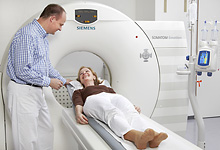|
Computed tomography (CT) is a modern "imaging" method that allows a detailed look into the human body. We have a Siemens Multislice Somatom Emotion 16-slice device at Radiology Rastatt.
|
Large parts of the body can be examined in a very short time. The special imaging technique avoids the overlaying of organs as it occurs in the x-ray image (summation image), which results in clearer diagnoses. Postprocessing of measured data can produce three-dimensional images of the examined area. Moreover, density measurements can be used to find out whether it is e.g. fatty tissue, liquid or solid tissue. Computed tomography has a very large field of application today. There is no other method that provides decisive information as quickly and precisely for examinations of the lungs, many questions regarding the abdomen and the quick examination of the head (e.g.) when searching for bleeding and injuries. Computed tomography is indispensable especially in case of accident or stroke.
|
|
|
More information |
|
We carry out the following examinations:
How is the examination realised? During the examination, the patients are lying, in most cases on their back, on a narrow bench that moves slowly into the ring-shaped opening of the system. It has a width of approx. 70 cm and the device is more like a ring than a "tube" which is why you do not need to feel constricted or have claustrophobia. During the examination, you can talk to the doctor or x-ray assistant at any time via an intercom system. The examination itself is completely painless and takes 2 to 10 minutes depending on the problem. You should lie as relaxed and calm as possible during the examination. An automatic voice might give you exact instructions on how to breathe. Please stick to these instructions, since the internal organs may appear different depending on respiration. |
Preparation for the examination Examinations of the head (skull and brain) as well as of the intervertebral disks and parts of the skeleton do not require any special preparation. About 45 minutes before the examination of the abdomen and the pelvis, a solution of 0.5 l water and 10-20 ml contrast agent containing iodine is given to drink in most cases so that the gastrointestinal tract can be visualised. In many cases, you have to come "nil by mouth" to the examination, that is you should not have eaten, drunk or smoked in the previous three hours. Contrast agents in CT Administration of contrast agents is required for many CT examinations. Contrast agents are used to improve the visualisation of blood vessels, tumours well supplied with blood or inflammations. They are injected into the arm vein and produce images that can be better evaluated. In case of examinations of the abdomen, it is possible that you may have to drink a contrast agent. In general, all contrast agents are tolerated well and are eliminated via the kidneys after a short time. Some persons show allergic reactions to iodine-containing contrast agents. Therefore, you have to complete a questionnaire before examinations with administration of contrast agent so that possible problems can already be recognised before the examination. If you are diabetic and take tablets (metformin), you have to stop taking them two days before the examination and may only start taking them again one day after the examination. Insulin injections do not interfere with the examination. |
Computed tomography (CT)
RadiologieZentrum Rastatt | Niederwaldstr. 23/1 | 76437 Rastatt | Telephone: +49 (0) 7222 10467-0 | Fax: +49 (0) 7222 10467-29





